Health Promotion Models and Theories: A Comparative Analysis
VerifiedAdded on 2019/09/13
|13
|2532
|1330
Essay
AI Summary
The assignment content discusses various theories of health behavior, including the Health Belief Model (HBM), Theory of Planned Behavior (TPB), and Transtheoretical Model (TTM). The HBM emphasizes the importance of perceived susceptibility, severity, and benefits in influencing health behavior. The TPB highlights the role of behavioral intention, subjective norms, social norms, perceived power, and perceived behavioral control in shaping health behavior. The TTM focuses on the stages of change, from precontemplation to maintenance, and how individuals progress through these stages. All three theories aim to understand and influence people's perceptions and behaviors towards healthier choices.
Contribute Materials
Your contribution can guide someone’s learning journey. Share your
documents today.
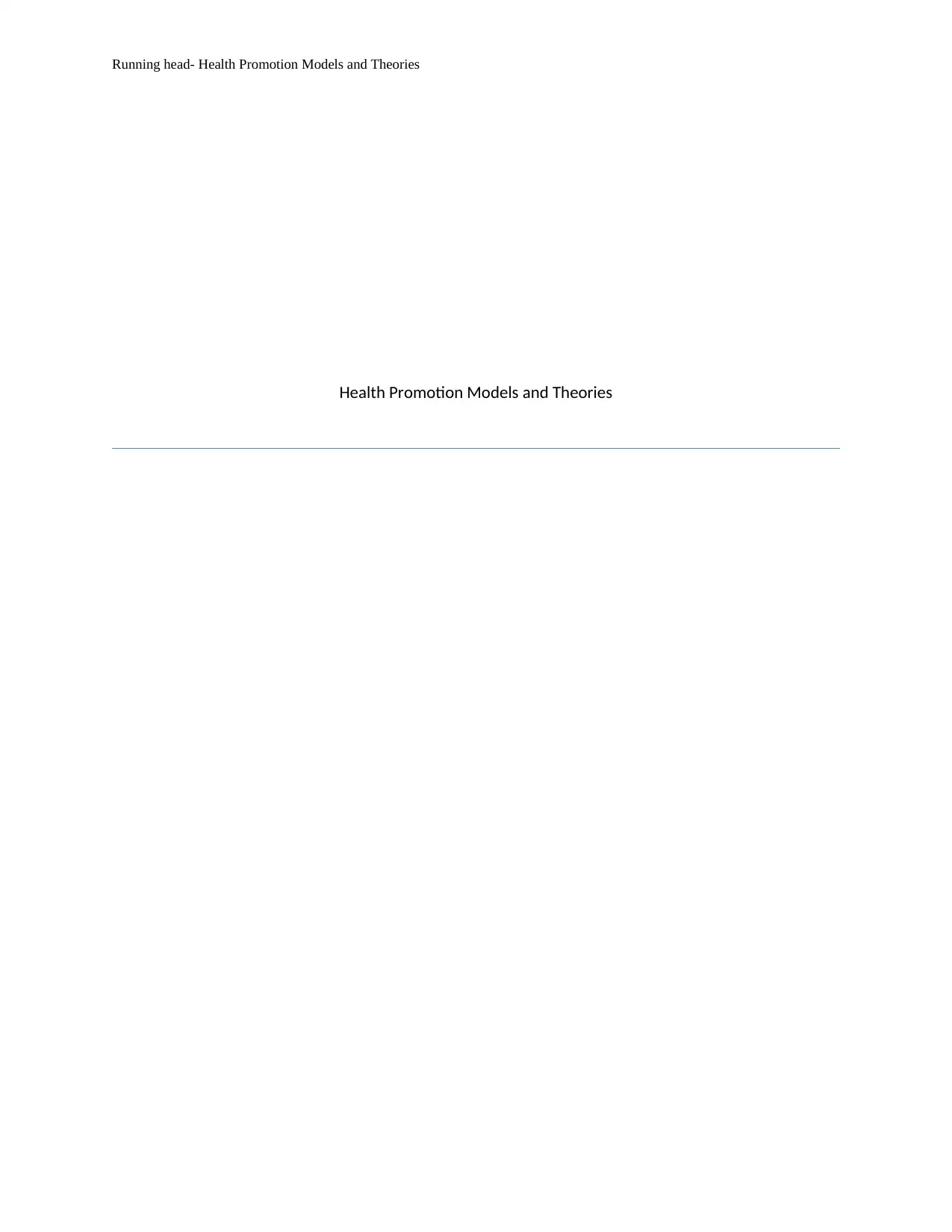
Running head- Health Promotion Models and Theories
Health Promotion Models and Theories
Health Promotion Models and Theories
Secure Best Marks with AI Grader
Need help grading? Try our AI Grader for instant feedback on your assignments.
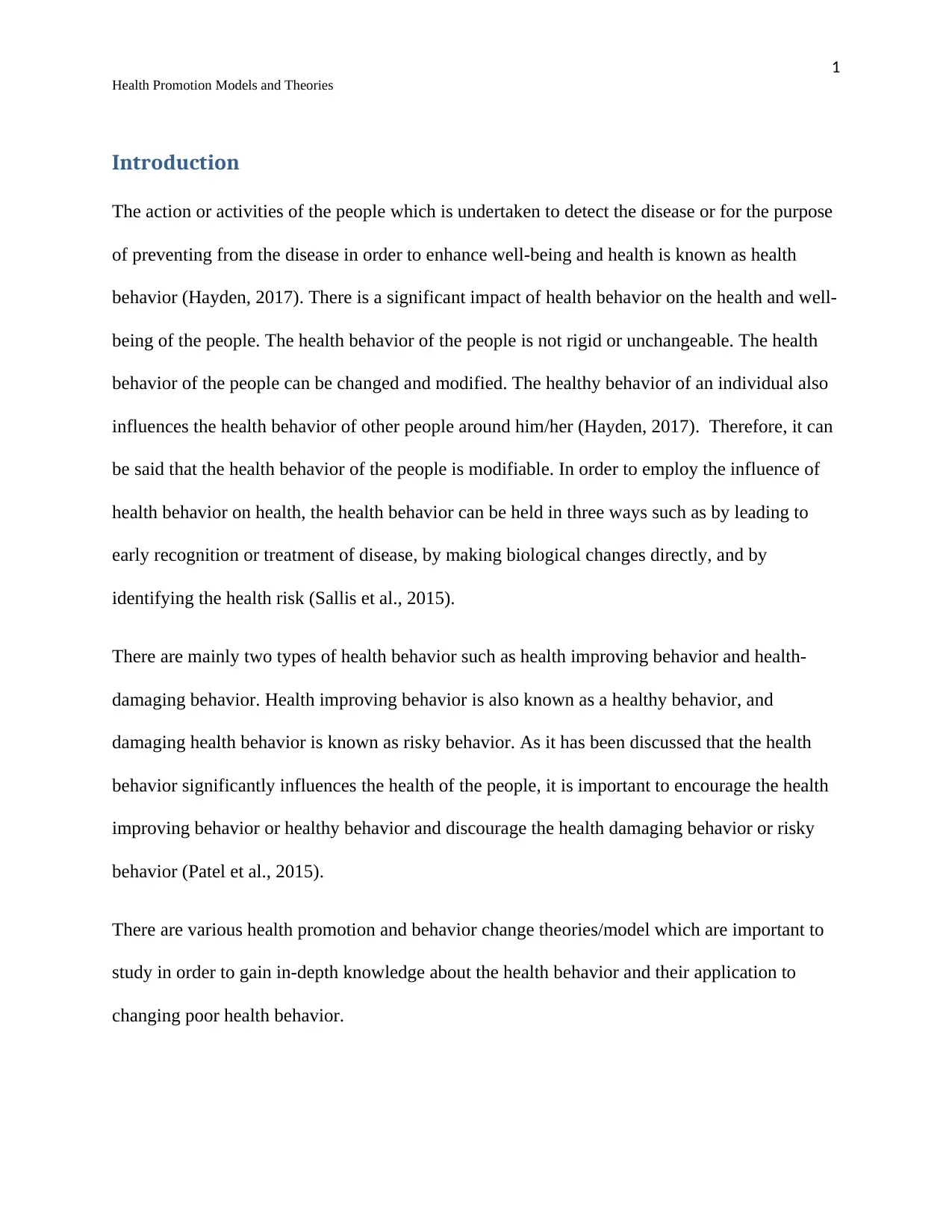
1
Health Promotion Models and Theories
Introduction
The action or activities of the people which is undertaken to detect the disease or for the purpose
of preventing from the disease in order to enhance well-being and health is known as health
behavior (Hayden, 2017). There is a significant impact of health behavior on the health and well-
being of the people. The health behavior of the people is not rigid or unchangeable. The health
behavior of the people can be changed and modified. The healthy behavior of an individual also
influences the health behavior of other people around him/her (Hayden, 2017). Therefore, it can
be said that the health behavior of the people is modifiable. In order to employ the influence of
health behavior on health, the health behavior can be held in three ways such as by leading to
early recognition or treatment of disease, by making biological changes directly, and by
identifying the health risk (Sallis et al., 2015).
There are mainly two types of health behavior such as health improving behavior and health-
damaging behavior. Health improving behavior is also known as a healthy behavior, and
damaging health behavior is known as risky behavior. As it has been discussed that the health
behavior significantly influences the health of the people, it is important to encourage the health
improving behavior or healthy behavior and discourage the health damaging behavior or risky
behavior (Patel et al., 2015).
There are various health promotion and behavior change theories/model which are important to
study in order to gain in-depth knowledge about the health behavior and their application to
changing poor health behavior.
Health Promotion Models and Theories
Introduction
The action or activities of the people which is undertaken to detect the disease or for the purpose
of preventing from the disease in order to enhance well-being and health is known as health
behavior (Hayden, 2017). There is a significant impact of health behavior on the health and well-
being of the people. The health behavior of the people is not rigid or unchangeable. The health
behavior of the people can be changed and modified. The healthy behavior of an individual also
influences the health behavior of other people around him/her (Hayden, 2017). Therefore, it can
be said that the health behavior of the people is modifiable. In order to employ the influence of
health behavior on health, the health behavior can be held in three ways such as by leading to
early recognition or treatment of disease, by making biological changes directly, and by
identifying the health risk (Sallis et al., 2015).
There are mainly two types of health behavior such as health improving behavior and health-
damaging behavior. Health improving behavior is also known as a healthy behavior, and
damaging health behavior is known as risky behavior. As it has been discussed that the health
behavior significantly influences the health of the people, it is important to encourage the health
improving behavior or healthy behavior and discourage the health damaging behavior or risky
behavior (Patel et al., 2015).
There are various health promotion and behavior change theories/model which are important to
study in order to gain in-depth knowledge about the health behavior and their application to
changing poor health behavior.
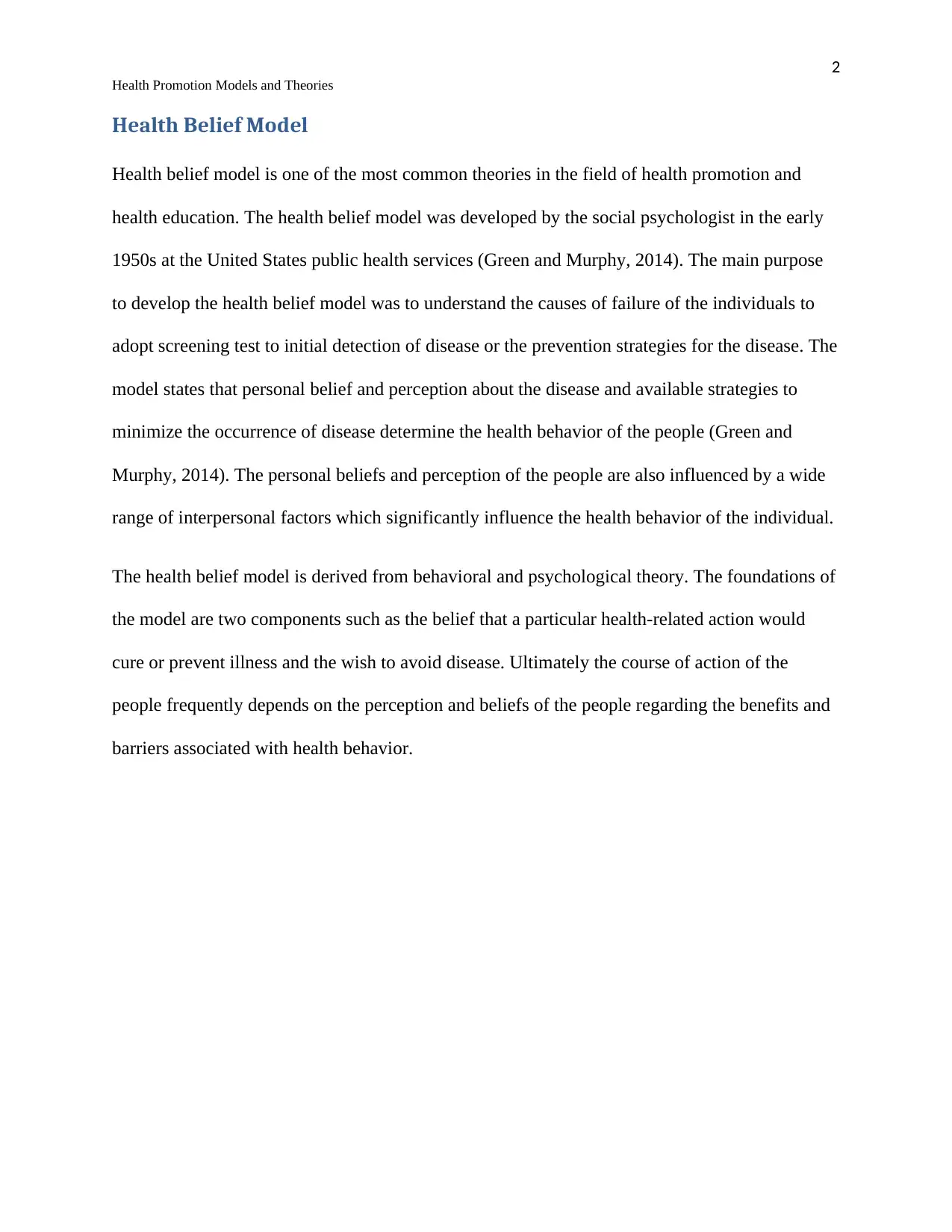
2
Health Promotion Models and Theories
Health Belief Model
Health belief model is one of the most common theories in the field of health promotion and
health education. The health belief model was developed by the social psychologist in the early
1950s at the United States public health services (Green and Murphy, 2014). The main purpose
to develop the health belief model was to understand the causes of failure of the individuals to
adopt screening test to initial detection of disease or the prevention strategies for the disease. The
model states that personal belief and perception about the disease and available strategies to
minimize the occurrence of disease determine the health behavior of the people (Green and
Murphy, 2014). The personal beliefs and perception of the people are also influenced by a wide
range of interpersonal factors which significantly influence the health behavior of the individual.
The health belief model is derived from behavioral and psychological theory. The foundations of
the model are two components such as the belief that a particular health-related action would
cure or prevent illness and the wish to avoid disease. Ultimately the course of action of the
people frequently depends on the perception and beliefs of the people regarding the benefits and
barriers associated with health behavior.
Health Promotion Models and Theories
Health Belief Model
Health belief model is one of the most common theories in the field of health promotion and
health education. The health belief model was developed by the social psychologist in the early
1950s at the United States public health services (Green and Murphy, 2014). The main purpose
to develop the health belief model was to understand the causes of failure of the individuals to
adopt screening test to initial detection of disease or the prevention strategies for the disease. The
model states that personal belief and perception about the disease and available strategies to
minimize the occurrence of disease determine the health behavior of the people (Green and
Murphy, 2014). The personal beliefs and perception of the people are also influenced by a wide
range of interpersonal factors which significantly influence the health behavior of the individual.
The health belief model is derived from behavioral and psychological theory. The foundations of
the model are two components such as the belief that a particular health-related action would
cure or prevent illness and the wish to avoid disease. Ultimately the course of action of the
people frequently depends on the perception and beliefs of the people regarding the benefits and
barriers associated with health behavior.
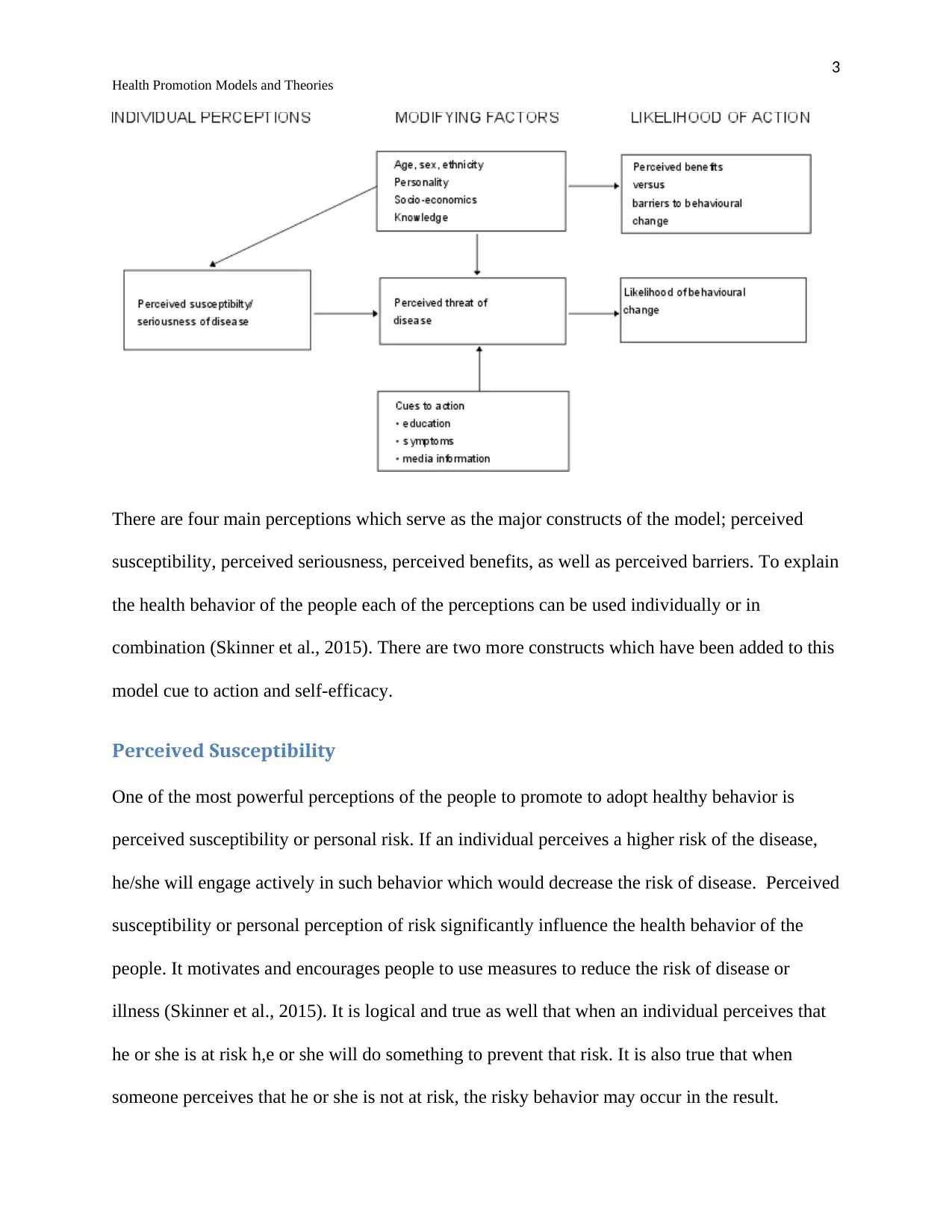
3
Health Promotion Models and Theories
There are four main perceptions which serve as the major constructs of the model; perceived
susceptibility, perceived seriousness, perceived benefits, as well as perceived barriers. To explain
the health behavior of the people each of the perceptions can be used individually or in
combination (Skinner et al., 2015). There are two more constructs which have been added to this
model cue to action and self-efficacy.
Perceived Susceptibility
One of the most powerful perceptions of the people to promote to adopt healthy behavior is
perceived susceptibility or personal risk. If an individual perceives a higher risk of the disease,
he/she will engage actively in such behavior which would decrease the risk of disease. Perceived
susceptibility or personal perception of risk significantly influence the health behavior of the
people. It motivates and encourages people to use measures to reduce the risk of disease or
illness (Skinner et al., 2015). It is logical and true as well that when an individual perceives that
he or she is at risk h,e or she will do something to prevent that risk. It is also true that when
someone perceives that he or she is not at risk, the risky behavior may occur in the result.
Health Promotion Models and Theories
There are four main perceptions which serve as the major constructs of the model; perceived
susceptibility, perceived seriousness, perceived benefits, as well as perceived barriers. To explain
the health behavior of the people each of the perceptions can be used individually or in
combination (Skinner et al., 2015). There are two more constructs which have been added to this
model cue to action and self-efficacy.
Perceived Susceptibility
One of the most powerful perceptions of the people to promote to adopt healthy behavior is
perceived susceptibility or personal risk. If an individual perceives a higher risk of the disease,
he/she will engage actively in such behavior which would decrease the risk of disease. Perceived
susceptibility or personal perception of risk significantly influence the health behavior of the
people. It motivates and encourages people to use measures to reduce the risk of disease or
illness (Skinner et al., 2015). It is logical and true as well that when an individual perceives that
he or she is at risk h,e or she will do something to prevent that risk. It is also true that when
someone perceives that he or she is not at risk, the risky behavior may occur in the result.
Secure Best Marks with AI Grader
Need help grading? Try our AI Grader for instant feedback on your assignments.
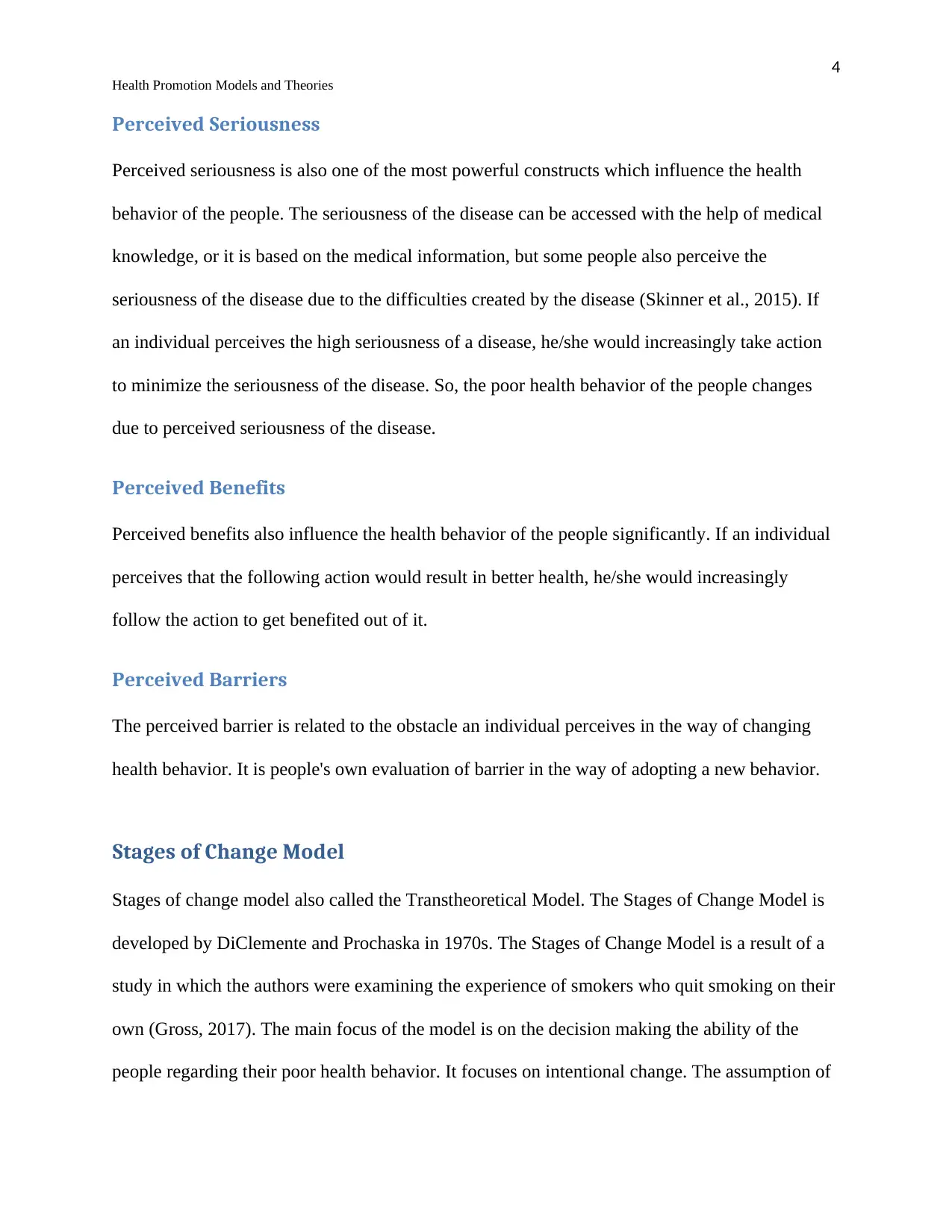
4
Health Promotion Models and Theories
Perceived Seriousness
Perceived seriousness is also one of the most powerful constructs which influence the health
behavior of the people. The seriousness of the disease can be accessed with the help of medical
knowledge, or it is based on the medical information, but some people also perceive the
seriousness of the disease due to the difficulties created by the disease (Skinner et al., 2015). If
an individual perceives the high seriousness of a disease, he/she would increasingly take action
to minimize the seriousness of the disease. So, the poor health behavior of the people changes
due to perceived seriousness of the disease.
Perceived Benefits
Perceived benefits also influence the health behavior of the people significantly. If an individual
perceives that the following action would result in better health, he/she would increasingly
follow the action to get benefited out of it.
Perceived Barriers
The perceived barrier is related to the obstacle an individual perceives in the way of changing
health behavior. It is people's own evaluation of barrier in the way of adopting a new behavior.
Stages of Change Model
Stages of change model also called the Transtheoretical Model. The Stages of Change Model is
developed by DiClemente and Prochaska in 1970s. The Stages of Change Model is a result of a
study in which the authors were examining the experience of smokers who quit smoking on their
own (Gross, 2017). The main focus of the model is on the decision making the ability of the
people regarding their poor health behavior. It focuses on intentional change. The assumption of
Health Promotion Models and Theories
Perceived Seriousness
Perceived seriousness is also one of the most powerful constructs which influence the health
behavior of the people. The seriousness of the disease can be accessed with the help of medical
knowledge, or it is based on the medical information, but some people also perceive the
seriousness of the disease due to the difficulties created by the disease (Skinner et al., 2015). If
an individual perceives the high seriousness of a disease, he/she would increasingly take action
to minimize the seriousness of the disease. So, the poor health behavior of the people changes
due to perceived seriousness of the disease.
Perceived Benefits
Perceived benefits also influence the health behavior of the people significantly. If an individual
perceives that the following action would result in better health, he/she would increasingly
follow the action to get benefited out of it.
Perceived Barriers
The perceived barrier is related to the obstacle an individual perceives in the way of changing
health behavior. It is people's own evaluation of barrier in the way of adopting a new behavior.
Stages of Change Model
Stages of change model also called the Transtheoretical Model. The Stages of Change Model is
developed by DiClemente and Prochaska in 1970s. The Stages of Change Model is a result of a
study in which the authors were examining the experience of smokers who quit smoking on their
own (Gross, 2017). The main focus of the model is on the decision making the ability of the
people regarding their poor health behavior. It focuses on intentional change. The assumption of
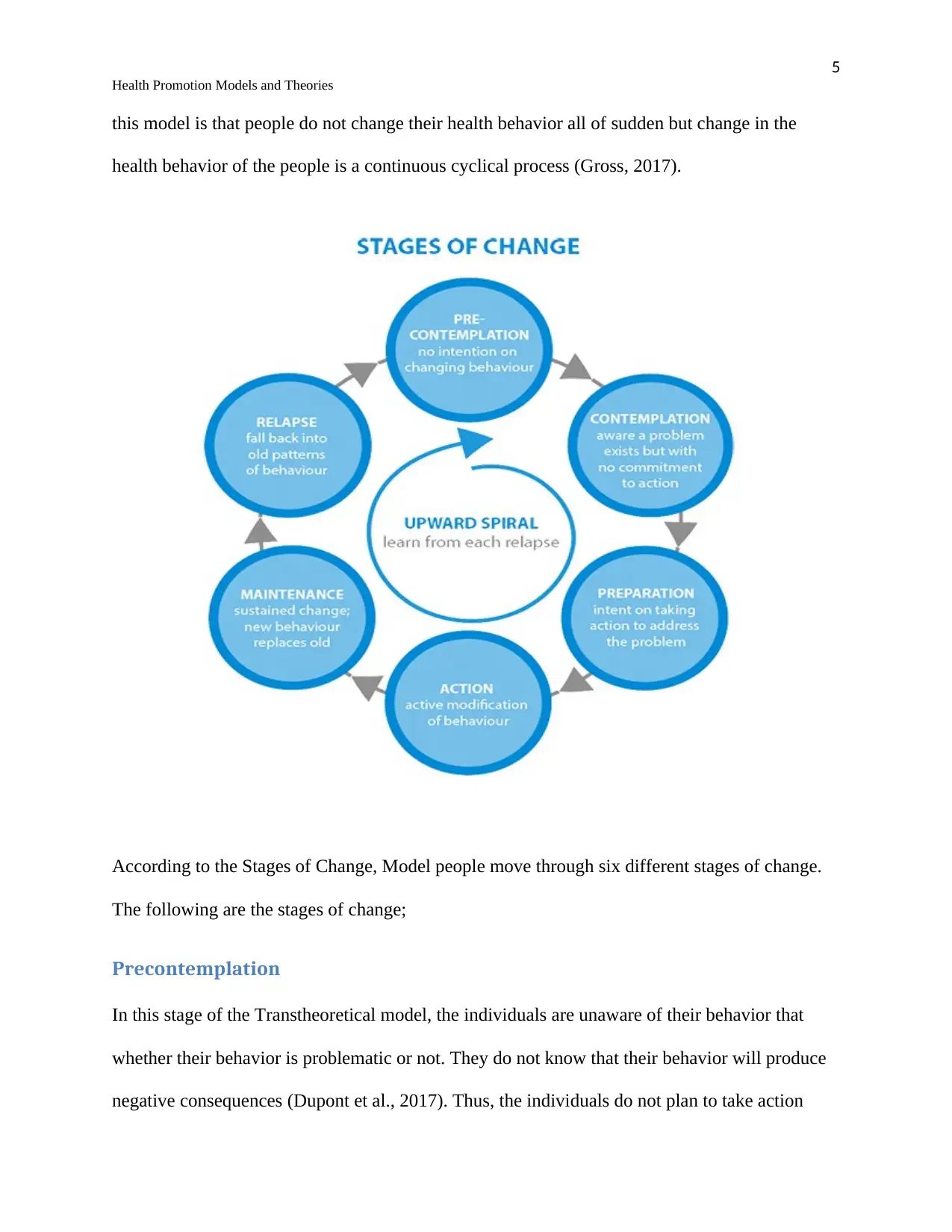
5
Health Promotion Models and Theories
this model is that people do not change their health behavior all of sudden but change in the
health behavior of the people is a continuous cyclical process (Gross, 2017).
According to the Stages of Change, Model people move through six different stages of change.
The following are the stages of change;
Precontemplation
In this stage of the Transtheoretical model, the individuals are unaware of their behavior that
whether their behavior is problematic or not. They do not know that their behavior will produce
negative consequences (Dupont et al., 2017). Thus, the individuals do not plan to take action
Health Promotion Models and Theories
this model is that people do not change their health behavior all of sudden but change in the
health behavior of the people is a continuous cyclical process (Gross, 2017).
According to the Stages of Change, Model people move through six different stages of change.
The following are the stages of change;
Precontemplation
In this stage of the Transtheoretical model, the individuals are unaware of their behavior that
whether their behavior is problematic or not. They do not know that their behavior will produce
negative consequences (Dupont et al., 2017). Thus, the individuals do not plan to take action
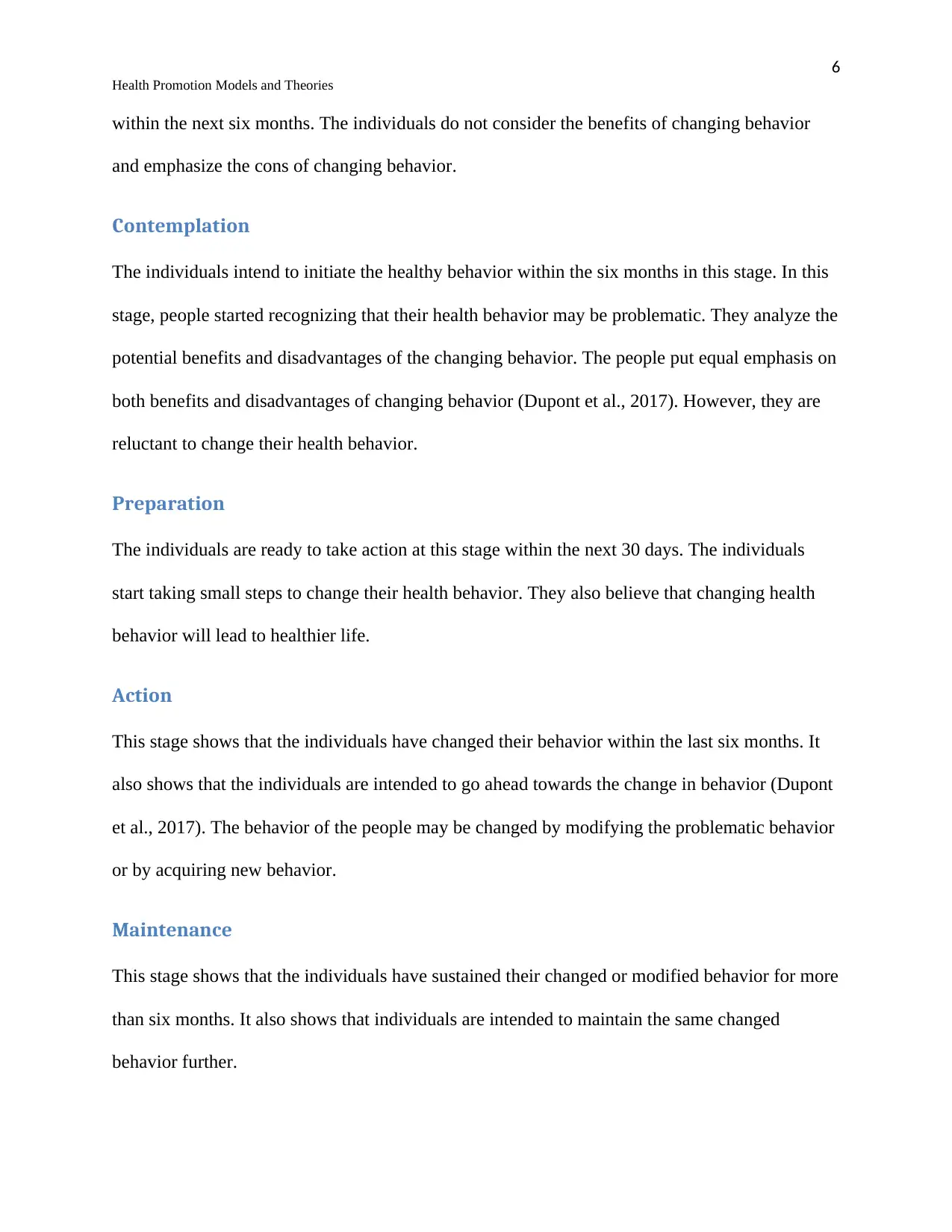
6
Health Promotion Models and Theories
within the next six months. The individuals do not consider the benefits of changing behavior
and emphasize the cons of changing behavior.
Contemplation
The individuals intend to initiate the healthy behavior within the six months in this stage. In this
stage, people started recognizing that their health behavior may be problematic. They analyze the
potential benefits and disadvantages of the changing behavior. The people put equal emphasis on
both benefits and disadvantages of changing behavior (Dupont et al., 2017). However, they are
reluctant to change their health behavior.
Preparation
The individuals are ready to take action at this stage within the next 30 days. The individuals
start taking small steps to change their health behavior. They also believe that changing health
behavior will lead to healthier life.
Action
This stage shows that the individuals have changed their behavior within the last six months. It
also shows that the individuals are intended to go ahead towards the change in behavior (Dupont
et al., 2017). The behavior of the people may be changed by modifying the problematic behavior
or by acquiring new behavior.
Maintenance
This stage shows that the individuals have sustained their changed or modified behavior for more
than six months. It also shows that individuals are intended to maintain the same changed
behavior further.
Health Promotion Models and Theories
within the next six months. The individuals do not consider the benefits of changing behavior
and emphasize the cons of changing behavior.
Contemplation
The individuals intend to initiate the healthy behavior within the six months in this stage. In this
stage, people started recognizing that their health behavior may be problematic. They analyze the
potential benefits and disadvantages of the changing behavior. The people put equal emphasis on
both benefits and disadvantages of changing behavior (Dupont et al., 2017). However, they are
reluctant to change their health behavior.
Preparation
The individuals are ready to take action at this stage within the next 30 days. The individuals
start taking small steps to change their health behavior. They also believe that changing health
behavior will lead to healthier life.
Action
This stage shows that the individuals have changed their behavior within the last six months. It
also shows that the individuals are intended to go ahead towards the change in behavior (Dupont
et al., 2017). The behavior of the people may be changed by modifying the problematic behavior
or by acquiring new behavior.
Maintenance
This stage shows that the individuals have sustained their changed or modified behavior for more
than six months. It also shows that individuals are intended to maintain the same changed
behavior further.
Paraphrase This Document
Need a fresh take? Get an instant paraphrase of this document with our AI Paraphraser
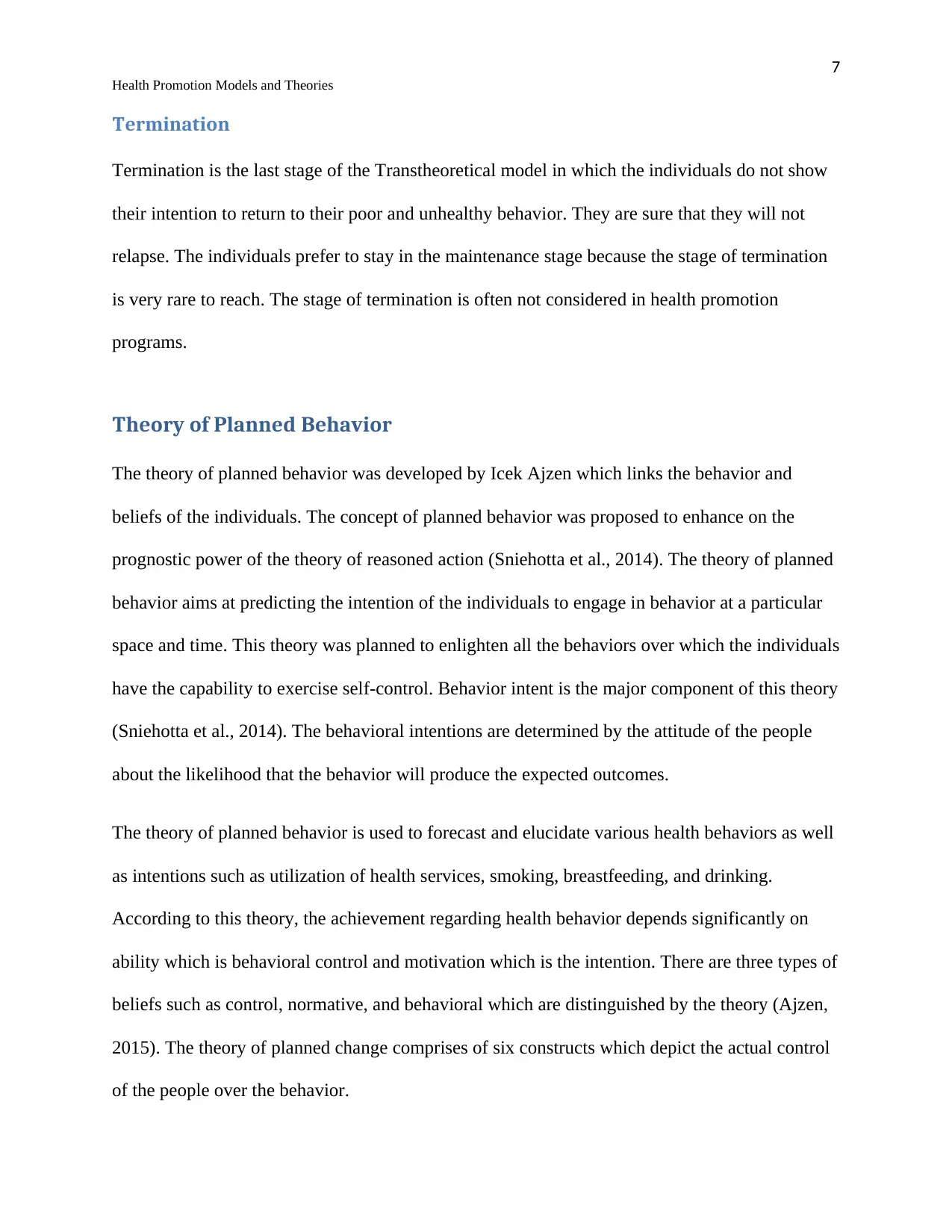
7
Health Promotion Models and Theories
Termination
Termination is the last stage of the Transtheoretical model in which the individuals do not show
their intention to return to their poor and unhealthy behavior. They are sure that they will not
relapse. The individuals prefer to stay in the maintenance stage because the stage of termination
is very rare to reach. The stage of termination is often not considered in health promotion
programs.
Theory of Planned Behavior
The theory of planned behavior was developed by Icek Ajzen which links the behavior and
beliefs of the individuals. The concept of planned behavior was proposed to enhance on the
prognostic power of the theory of reasoned action (Sniehotta et al., 2014). The theory of planned
behavior aims at predicting the intention of the individuals to engage in behavior at a particular
space and time. This theory was planned to enlighten all the behaviors over which the individuals
have the capability to exercise self-control. Behavior intent is the major component of this theory
(Sniehotta et al., 2014). The behavioral intentions are determined by the attitude of the people
about the likelihood that the behavior will produce the expected outcomes.
The theory of planned behavior is used to forecast and elucidate various health behaviors as well
as intentions such as utilization of health services, smoking, breastfeeding, and drinking.
According to this theory, the achievement regarding health behavior depends significantly on
ability which is behavioral control and motivation which is the intention. There are three types of
beliefs such as control, normative, and behavioral which are distinguished by the theory (Ajzen,
2015). The theory of planned change comprises of six constructs which depict the actual control
of the people over the behavior.
Health Promotion Models and Theories
Termination
Termination is the last stage of the Transtheoretical model in which the individuals do not show
their intention to return to their poor and unhealthy behavior. They are sure that they will not
relapse. The individuals prefer to stay in the maintenance stage because the stage of termination
is very rare to reach. The stage of termination is often not considered in health promotion
programs.
Theory of Planned Behavior
The theory of planned behavior was developed by Icek Ajzen which links the behavior and
beliefs of the individuals. The concept of planned behavior was proposed to enhance on the
prognostic power of the theory of reasoned action (Sniehotta et al., 2014). The theory of planned
behavior aims at predicting the intention of the individuals to engage in behavior at a particular
space and time. This theory was planned to enlighten all the behaviors over which the individuals
have the capability to exercise self-control. Behavior intent is the major component of this theory
(Sniehotta et al., 2014). The behavioral intentions are determined by the attitude of the people
about the likelihood that the behavior will produce the expected outcomes.
The theory of planned behavior is used to forecast and elucidate various health behaviors as well
as intentions such as utilization of health services, smoking, breastfeeding, and drinking.
According to this theory, the achievement regarding health behavior depends significantly on
ability which is behavioral control and motivation which is the intention. There are three types of
beliefs such as control, normative, and behavioral which are distinguished by the theory (Ajzen,
2015). The theory of planned change comprises of six constructs which depict the actual control
of the people over the behavior.
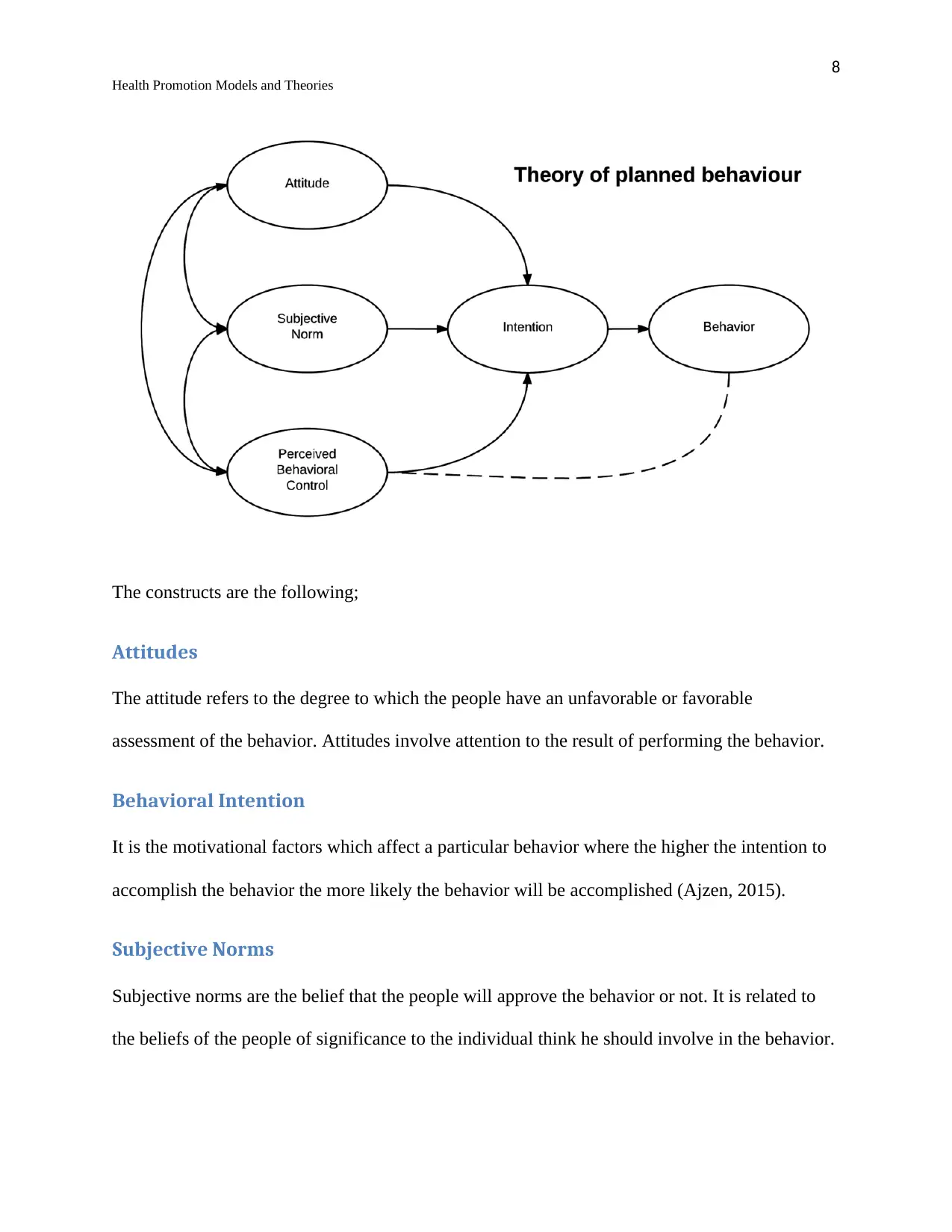
8
Health Promotion Models and Theories
The constructs are the following;
Attitudes
The attitude refers to the degree to which the people have an unfavorable or favorable
assessment of the behavior. Attitudes involve attention to the result of performing the behavior.
Behavioral Intention
It is the motivational factors which affect a particular behavior where the higher the intention to
accomplish the behavior the more likely the behavior will be accomplished (Ajzen, 2015).
Subjective Norms
Subjective norms are the belief that the people will approve the behavior or not. It is related to
the beliefs of the people of significance to the individual think he should involve in the behavior.
Health Promotion Models and Theories
The constructs are the following;
Attitudes
The attitude refers to the degree to which the people have an unfavorable or favorable
assessment of the behavior. Attitudes involve attention to the result of performing the behavior.
Behavioral Intention
It is the motivational factors which affect a particular behavior where the higher the intention to
accomplish the behavior the more likely the behavior will be accomplished (Ajzen, 2015).
Subjective Norms
Subjective norms are the belief that the people will approve the behavior or not. It is related to
the beliefs of the people of significance to the individual think he should involve in the behavior.
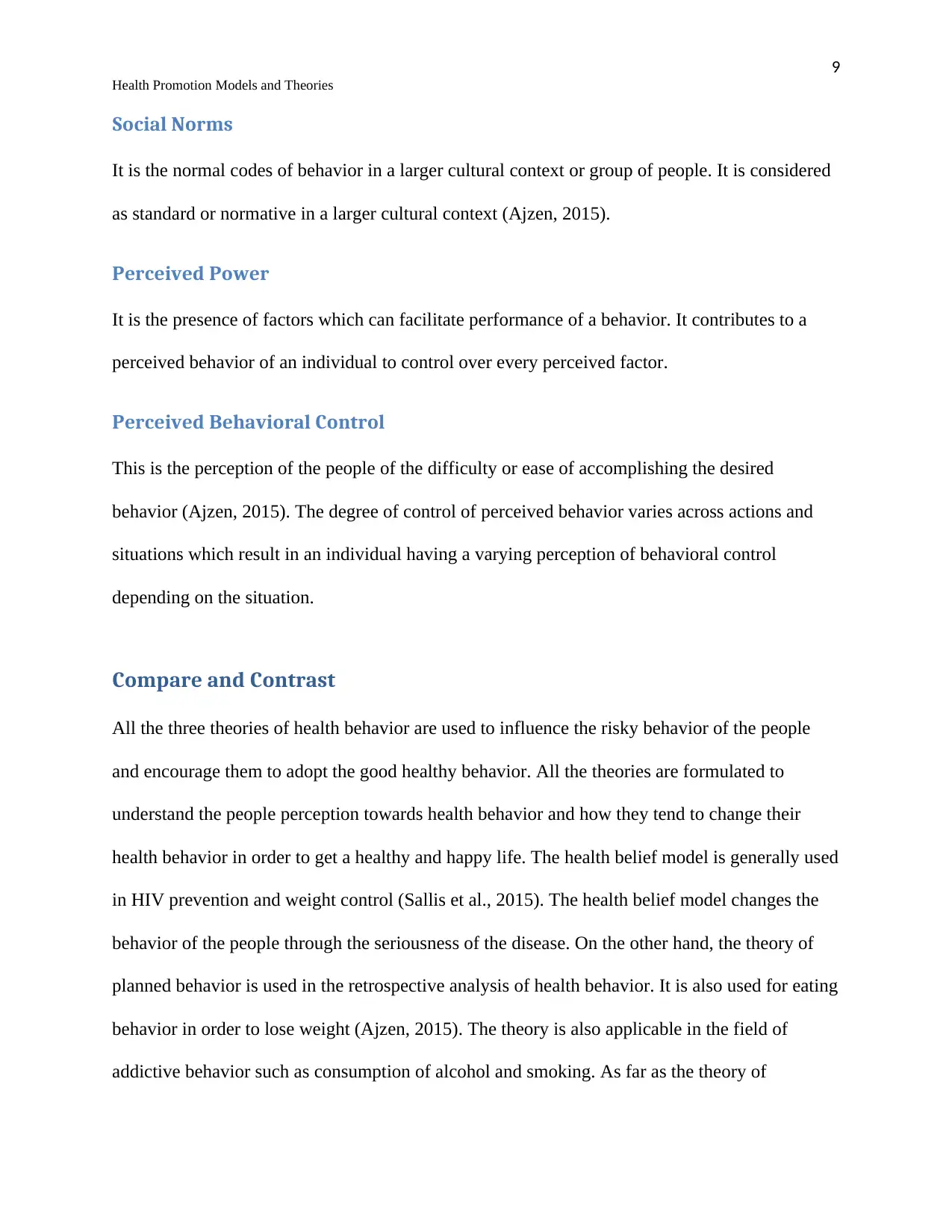
9
Health Promotion Models and Theories
Social Norms
It is the normal codes of behavior in a larger cultural context or group of people. It is considered
as standard or normative in a larger cultural context (Ajzen, 2015).
Perceived Power
It is the presence of factors which can facilitate performance of a behavior. It contributes to a
perceived behavior of an individual to control over every perceived factor.
Perceived Behavioral Control
This is the perception of the people of the difficulty or ease of accomplishing the desired
behavior (Ajzen, 2015). The degree of control of perceived behavior varies across actions and
situations which result in an individual having a varying perception of behavioral control
depending on the situation.
Compare and Contrast
All the three theories of health behavior are used to influence the risky behavior of the people
and encourage them to adopt the good healthy behavior. All the theories are formulated to
understand the people perception towards health behavior and how they tend to change their
health behavior in order to get a healthy and happy life. The health belief model is generally used
in HIV prevention and weight control (Sallis et al., 2015). The health belief model changes the
behavior of the people through the seriousness of the disease. On the other hand, the theory of
planned behavior is used in the retrospective analysis of health behavior. It is also used for eating
behavior in order to lose weight (Ajzen, 2015). The theory is also applicable in the field of
addictive behavior such as consumption of alcohol and smoking. As far as the theory of
Health Promotion Models and Theories
Social Norms
It is the normal codes of behavior in a larger cultural context or group of people. It is considered
as standard or normative in a larger cultural context (Ajzen, 2015).
Perceived Power
It is the presence of factors which can facilitate performance of a behavior. It contributes to a
perceived behavior of an individual to control over every perceived factor.
Perceived Behavioral Control
This is the perception of the people of the difficulty or ease of accomplishing the desired
behavior (Ajzen, 2015). The degree of control of perceived behavior varies across actions and
situations which result in an individual having a varying perception of behavioral control
depending on the situation.
Compare and Contrast
All the three theories of health behavior are used to influence the risky behavior of the people
and encourage them to adopt the good healthy behavior. All the theories are formulated to
understand the people perception towards health behavior and how they tend to change their
health behavior in order to get a healthy and happy life. The health belief model is generally used
in HIV prevention and weight control (Sallis et al., 2015). The health belief model changes the
behavior of the people through the seriousness of the disease. On the other hand, the theory of
planned behavior is used in the retrospective analysis of health behavior. It is also used for eating
behavior in order to lose weight (Ajzen, 2015). The theory is also applicable in the field of
addictive behavior such as consumption of alcohol and smoking. As far as the theory of
Secure Best Marks with AI Grader
Need help grading? Try our AI Grader for instant feedback on your assignments.
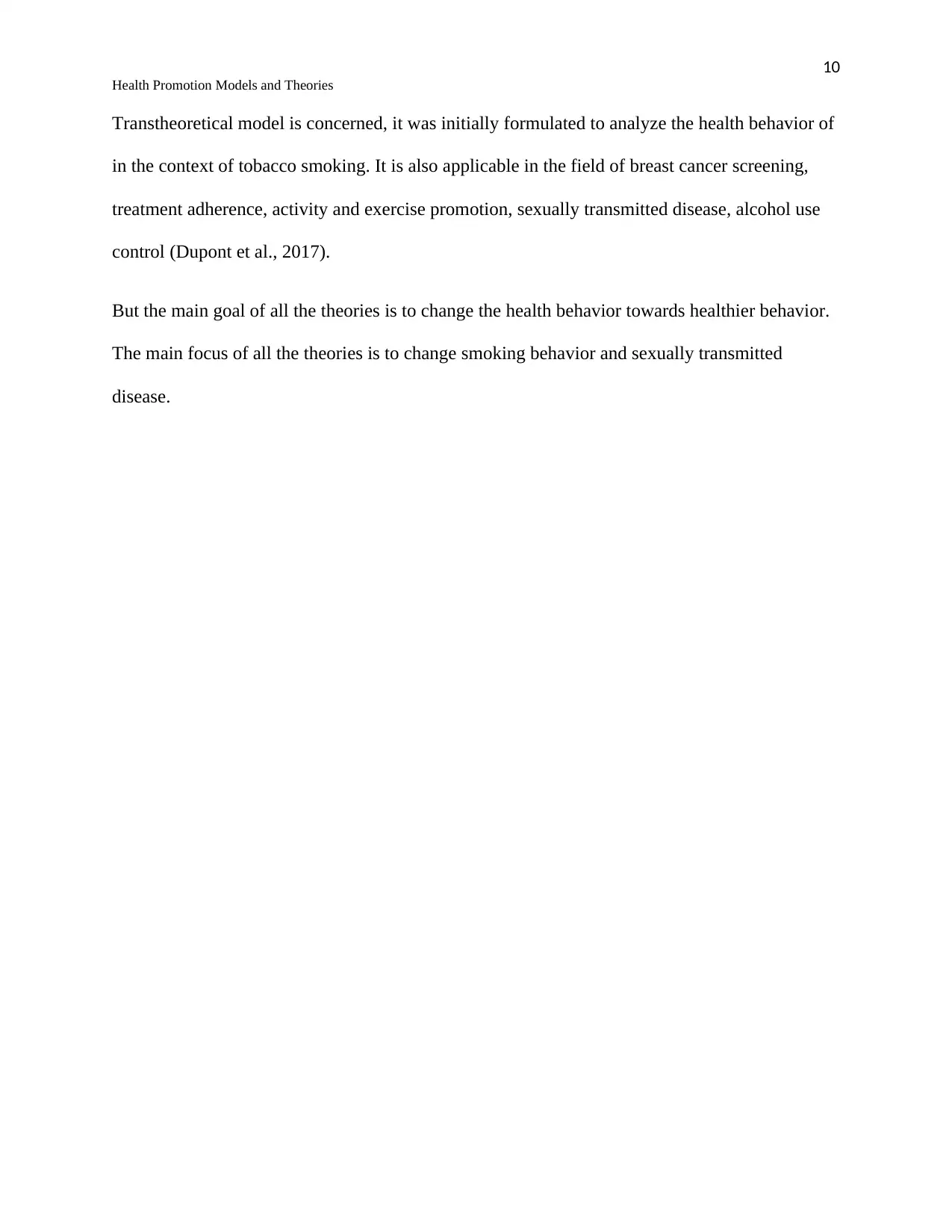
10
Health Promotion Models and Theories
Transtheoretical model is concerned, it was initially formulated to analyze the health behavior of
in the context of tobacco smoking. It is also applicable in the field of breast cancer screening,
treatment adherence, activity and exercise promotion, sexually transmitted disease, alcohol use
control (Dupont et al., 2017).
But the main goal of all the theories is to change the health behavior towards healthier behavior.
The main focus of all the theories is to change smoking behavior and sexually transmitted
disease.
Health Promotion Models and Theories
Transtheoretical model is concerned, it was initially formulated to analyze the health behavior of
in the context of tobacco smoking. It is also applicable in the field of breast cancer screening,
treatment adherence, activity and exercise promotion, sexually transmitted disease, alcohol use
control (Dupont et al., 2017).
But the main goal of all the theories is to change the health behavior towards healthier behavior.
The main focus of all the theories is to change smoking behavior and sexually transmitted
disease.
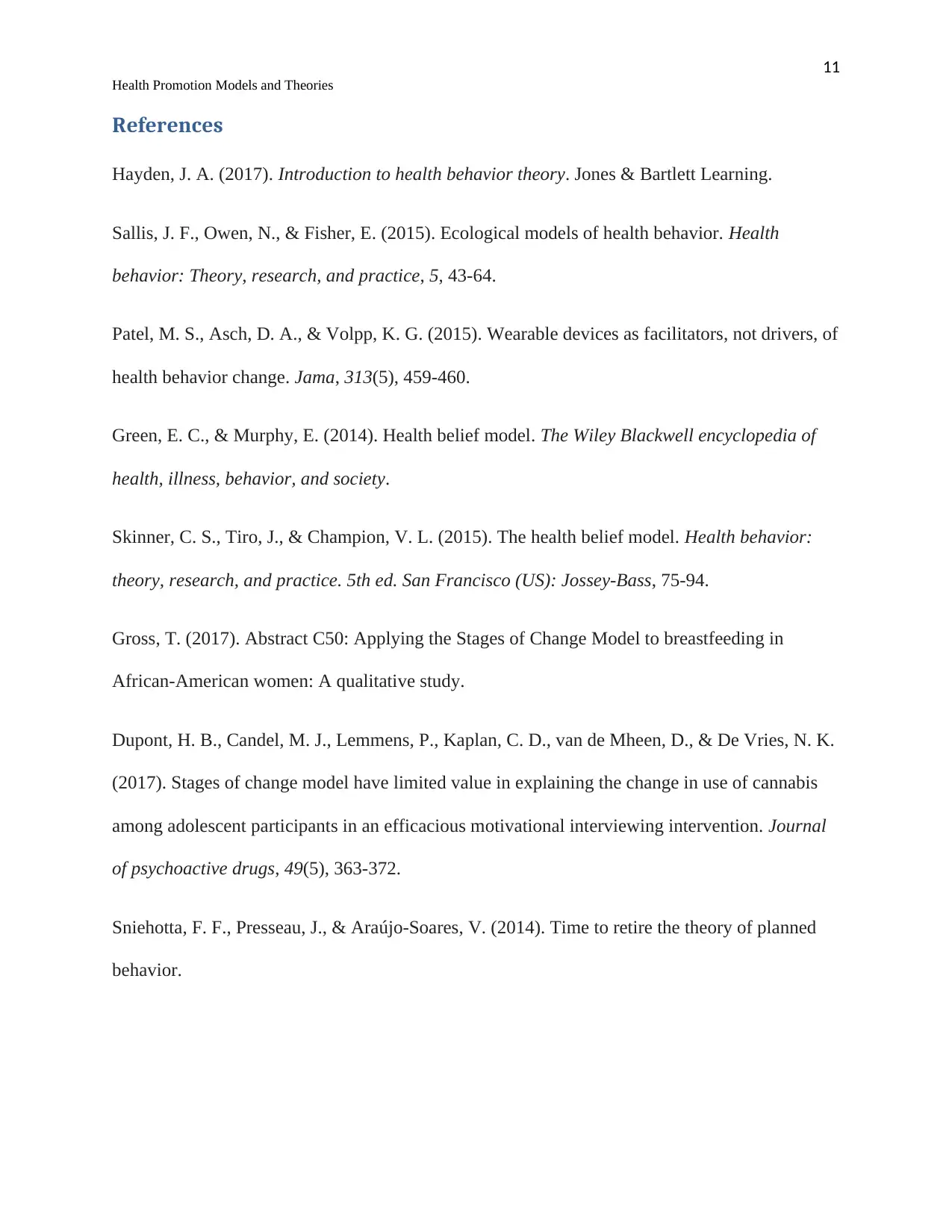
11
Health Promotion Models and Theories
References
Hayden, J. A. (2017). Introduction to health behavior theory. Jones & Bartlett Learning.
Sallis, J. F., Owen, N., & Fisher, E. (2015). Ecological models of health behavior. Health
behavior: Theory, research, and practice, 5, 43-64.
Patel, M. S., Asch, D. A., & Volpp, K. G. (2015). Wearable devices as facilitators, not drivers, of
health behavior change. Jama, 313(5), 459-460.
Green, E. C., & Murphy, E. (2014). Health belief model. The Wiley Blackwell encyclopedia of
health, illness, behavior, and society.
Skinner, C. S., Tiro, J., & Champion, V. L. (2015). The health belief model. Health behavior:
theory, research, and practice. 5th ed. San Francisco (US): Jossey-Bass, 75-94.
Gross, T. (2017). Abstract C50: Applying the Stages of Change Model to breastfeeding in
African-American women: A qualitative study.
Dupont, H. B., Candel, M. J., Lemmens, P., Kaplan, C. D., van de Mheen, D., & De Vries, N. K.
(2017). Stages of change model have limited value in explaining the change in use of cannabis
among adolescent participants in an efficacious motivational interviewing intervention. Journal
of psychoactive drugs, 49(5), 363-372.
Sniehotta, F. F., Presseau, J., & Araújo-Soares, V. (2014). Time to retire the theory of planned
behavior.
Health Promotion Models and Theories
References
Hayden, J. A. (2017). Introduction to health behavior theory. Jones & Bartlett Learning.
Sallis, J. F., Owen, N., & Fisher, E. (2015). Ecological models of health behavior. Health
behavior: Theory, research, and practice, 5, 43-64.
Patel, M. S., Asch, D. A., & Volpp, K. G. (2015). Wearable devices as facilitators, not drivers, of
health behavior change. Jama, 313(5), 459-460.
Green, E. C., & Murphy, E. (2014). Health belief model. The Wiley Blackwell encyclopedia of
health, illness, behavior, and society.
Skinner, C. S., Tiro, J., & Champion, V. L. (2015). The health belief model. Health behavior:
theory, research, and practice. 5th ed. San Francisco (US): Jossey-Bass, 75-94.
Gross, T. (2017). Abstract C50: Applying the Stages of Change Model to breastfeeding in
African-American women: A qualitative study.
Dupont, H. B., Candel, M. J., Lemmens, P., Kaplan, C. D., van de Mheen, D., & De Vries, N. K.
(2017). Stages of change model have limited value in explaining the change in use of cannabis
among adolescent participants in an efficacious motivational interviewing intervention. Journal
of psychoactive drugs, 49(5), 363-372.
Sniehotta, F. F., Presseau, J., & Araújo-Soares, V. (2014). Time to retire the theory of planned
behavior.
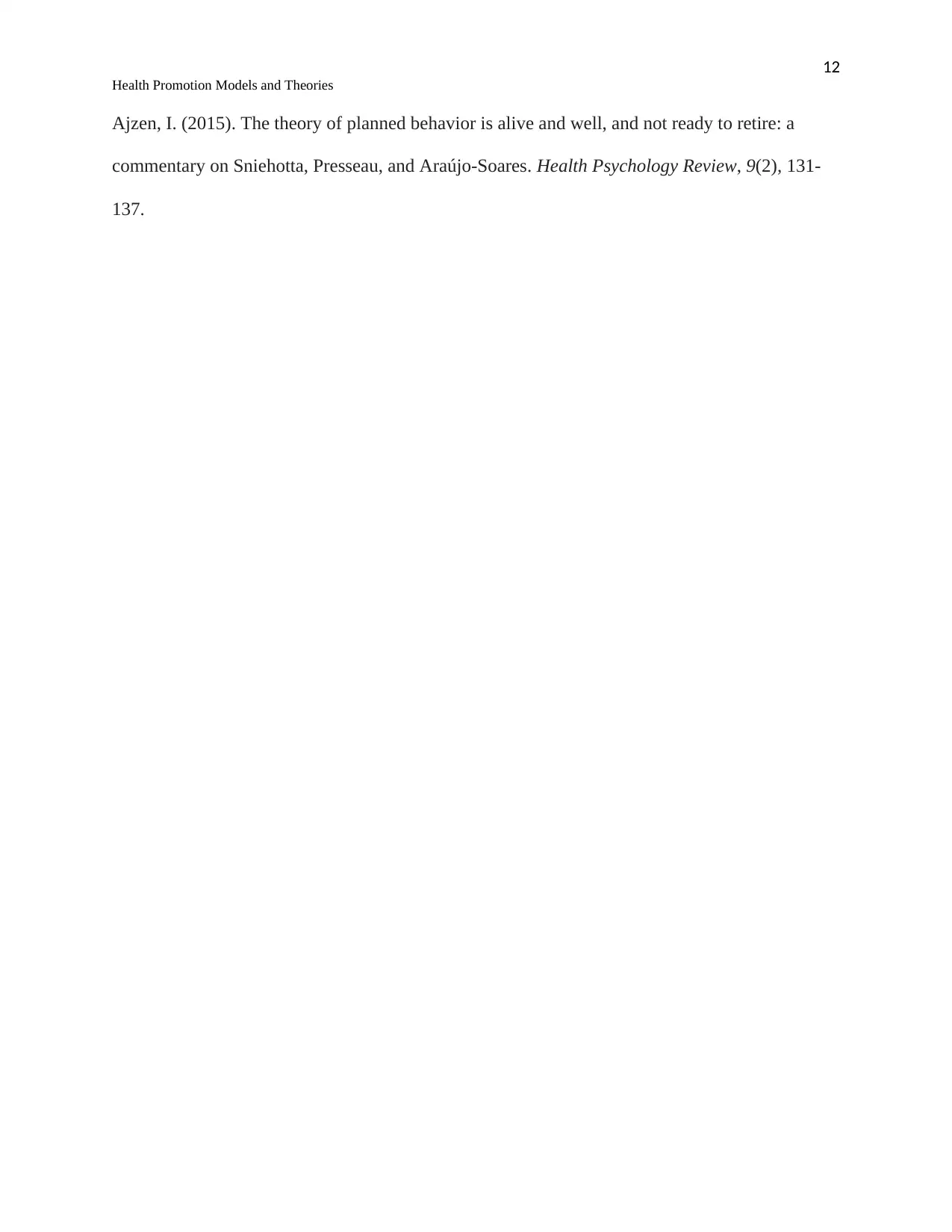
12
Health Promotion Models and Theories
Ajzen, I. (2015). The theory of planned behavior is alive and well, and not ready to retire: a
commentary on Sniehotta, Presseau, and Araújo-Soares. Health Psychology Review, 9(2), 131-
137.
Health Promotion Models and Theories
Ajzen, I. (2015). The theory of planned behavior is alive and well, and not ready to retire: a
commentary on Sniehotta, Presseau, and Araújo-Soares. Health Psychology Review, 9(2), 131-
137.
1 out of 13
Your All-in-One AI-Powered Toolkit for Academic Success.
+13062052269
info@desklib.com
Available 24*7 on WhatsApp / Email
![[object Object]](/_next/static/media/star-bottom.7253800d.svg)
Unlock your academic potential
© 2024 | Zucol Services PVT LTD | All rights reserved.